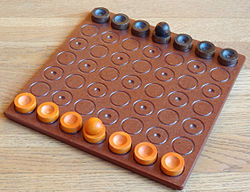- Diaballik
-
Diaballik
Screenshot of the gamePlayers 2 Age range 8+ Setup time 30 seconds Playing time 20 minutes Random chance None Skill(s) required Tactics, Strategy Diaballik is an abstract strategy board game designed by Philippe Lefrançois. It attempts to simulate a sport whereby 2 teams are simultaneously trying to get their ball to the opposite teams starting goal line. The board depicts a 7x7 grid.
Contents
Rules
The Diaballik's rules are simple and are explained here.[1] Each opponent has a team composed of seven players, one of those having a ball. There is no mechanism of catch of players, so there are always 14 players in the game.
The goal of the game is to bring a player in the opponent's side with the ball.
Opponents play alternatively and can achieve three actions during their turn in any order; two moves and one ball throw. Of course, it is not necessary to make the three actions.
The player with the ball can throw his ball to another player of his team which is located in the vertical line, the horizontal line or a diagonal line and if no adverse player can intercept the ball. As in handball, the player with the ball cannot move while he has the ball. So if he wants to move, he first needs to send the ball to one of his partners and then move. Players' moves can only be made in the horizontal or vertical adjacent case if it is empty. So a diagonal move is possible but it needs two moves.
Anti-game rule
Opponents need to bring at least one of their players in the adverse side. But if all players of a team are adjacent, one per column, the adverse team will not be able to reach the adverse side, because they form an uncrossable line. The "anti-game" rule dissuades opponents to make an uncrossable line. In practice the "anti-game" rule specifies that if an opponent put its players in a uncrossable line and that at least three adverse players are adjacent to this line, then the adverse players win.
Variant
With the variant configuration, it is possible to attack very quickly.
Strategy
Diaballik deserves its name well. Rules are simple and the strategy is hard. At each turn, the number of possibilities to play is quite important (in average between 200 and 1000). To win it is essential to attack but it is also crucial to defend from the enemy's attacks.
References
External links
Categories:- Abstract strategy games
Wikimedia Foundation. 2010.

